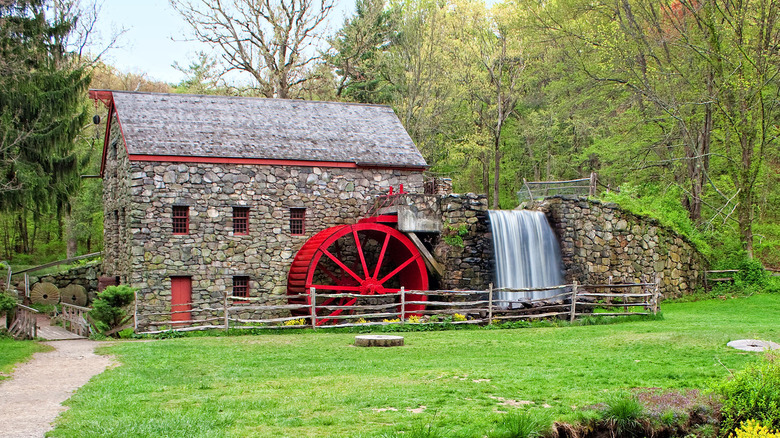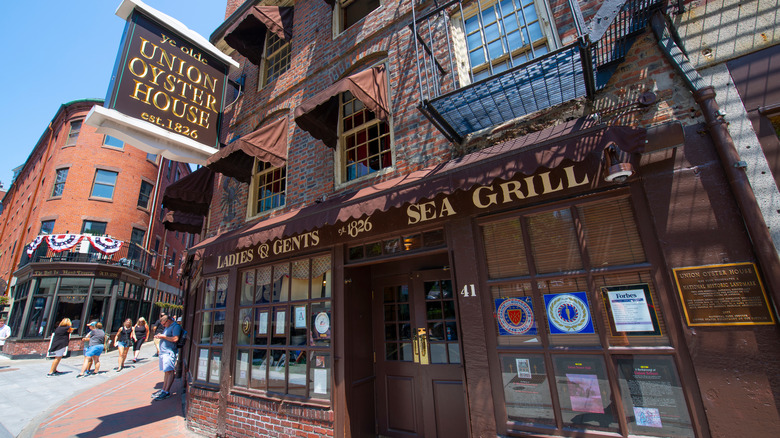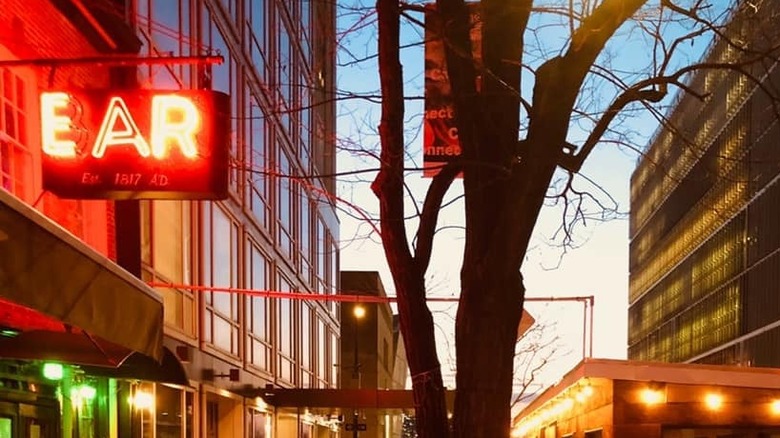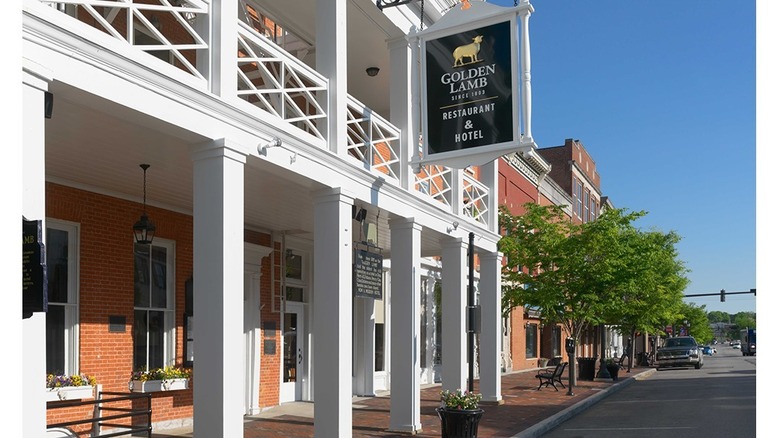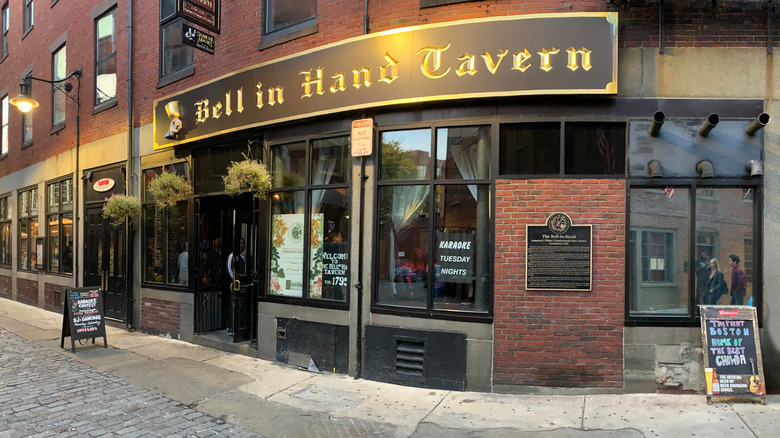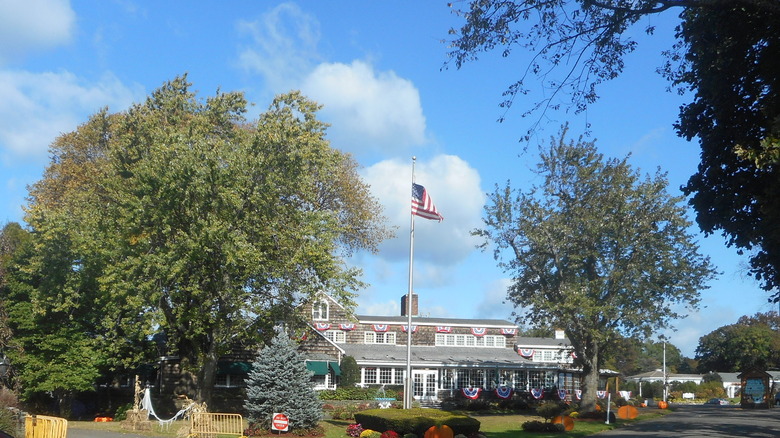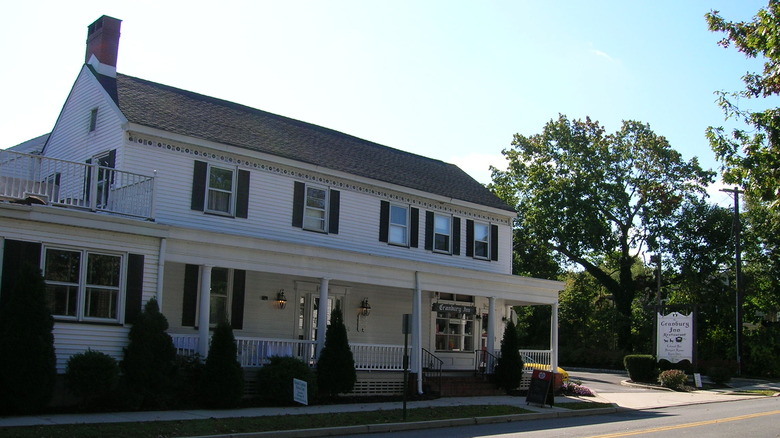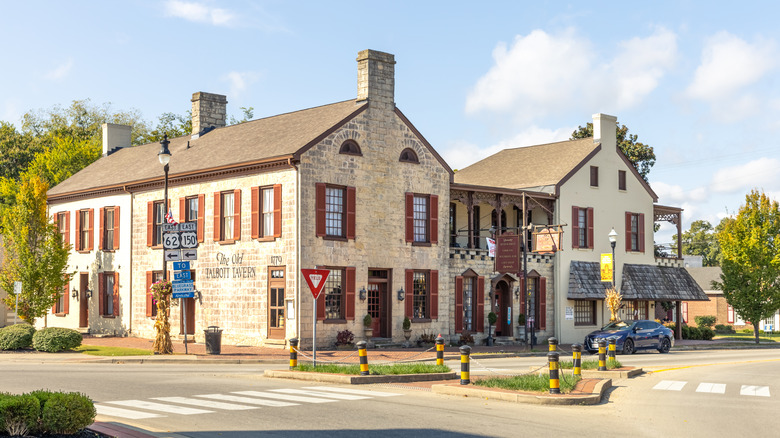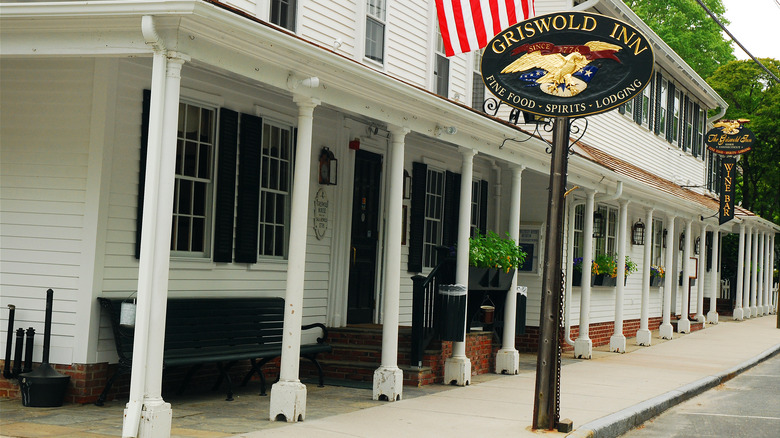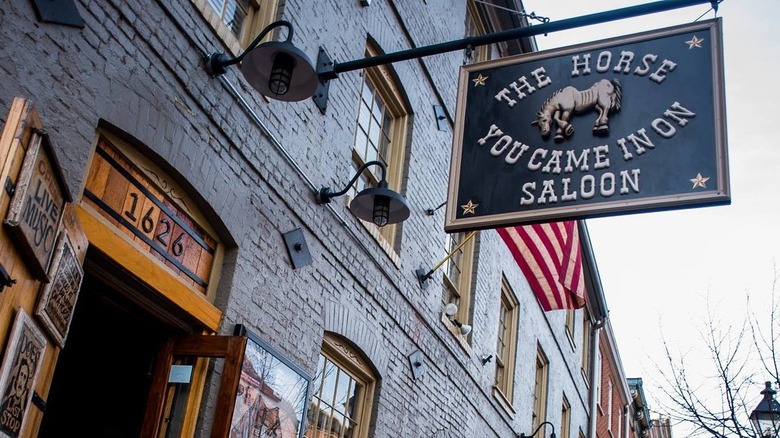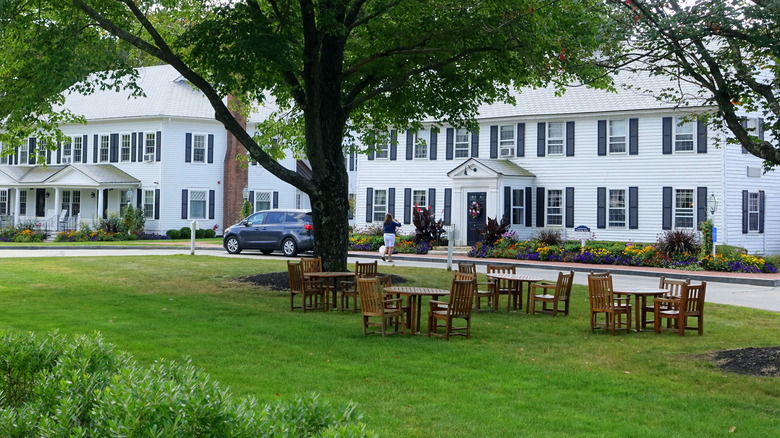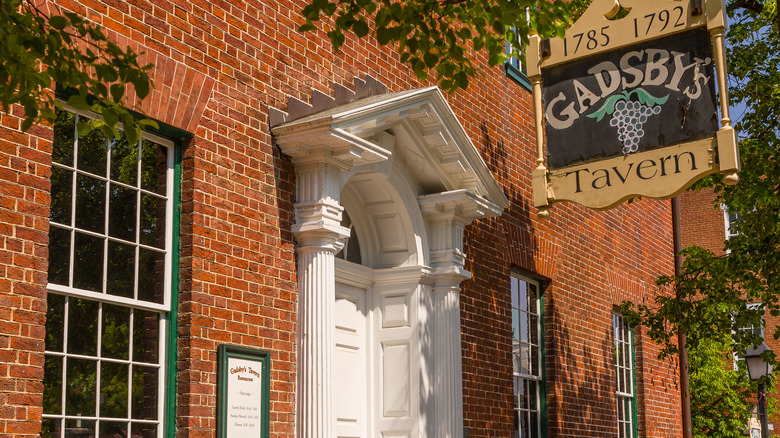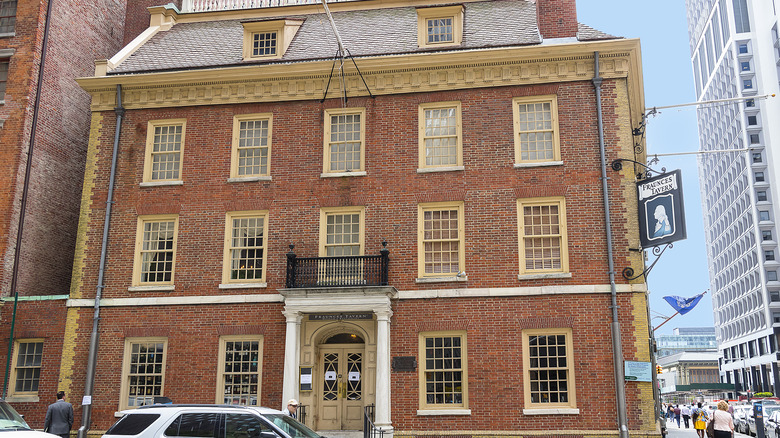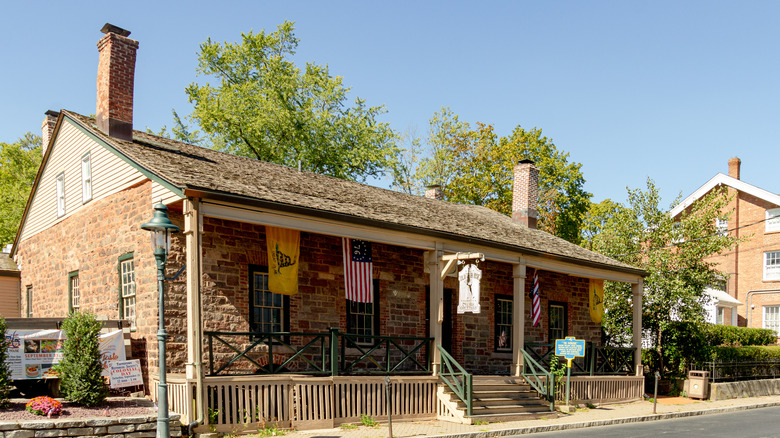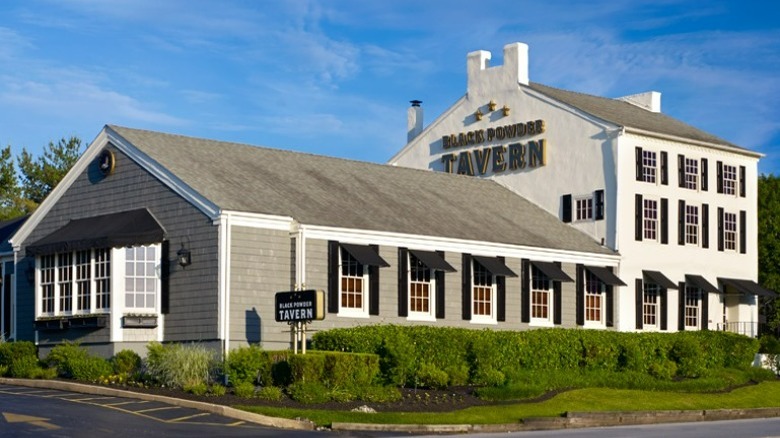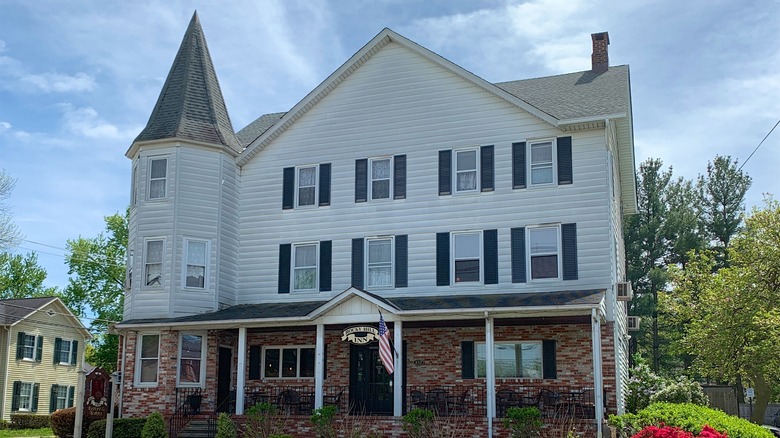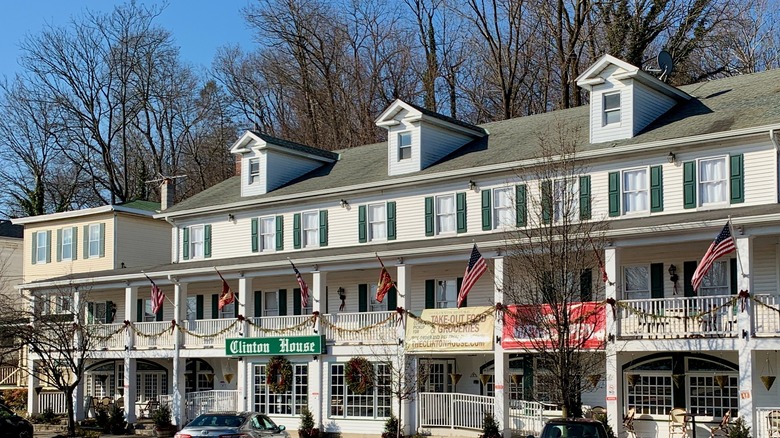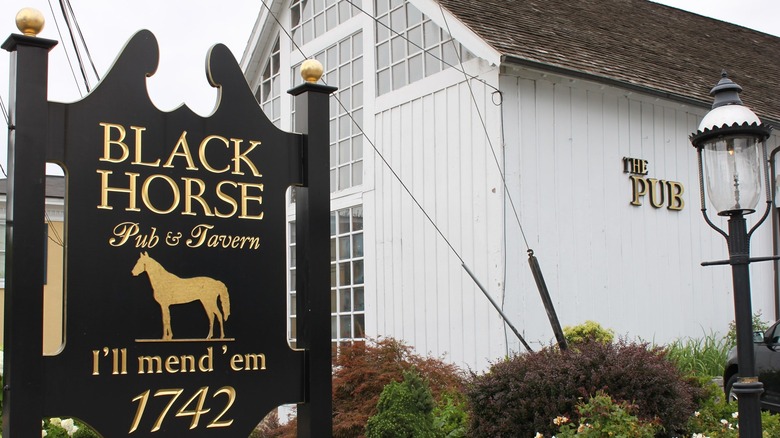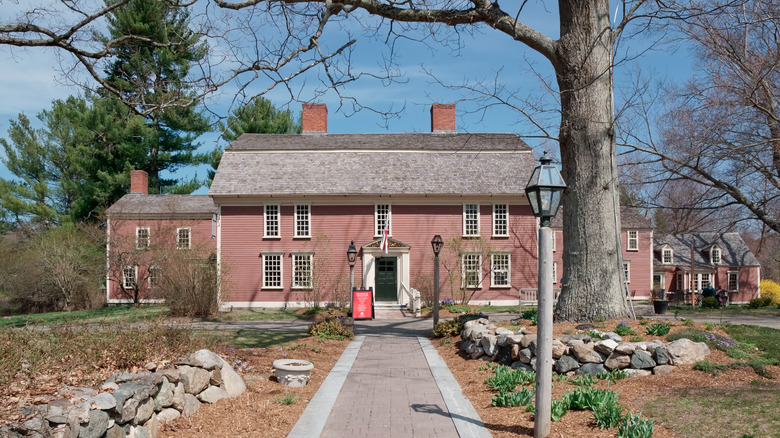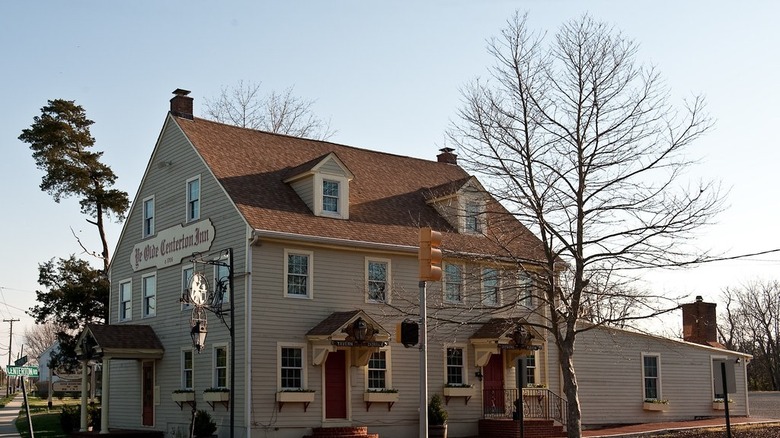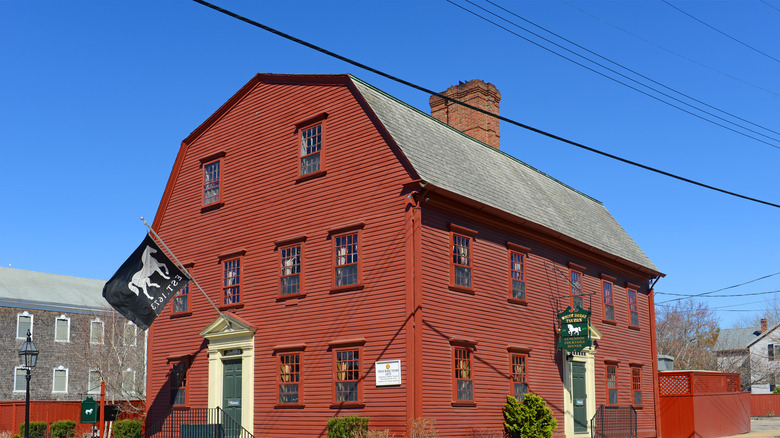These Are The Oldest Restaurants In America
Inns have sheltered travelers forever, like the Keiunkan inn in Yamanashi, Japan, opened over 1,300 years ago. The United States is a much younger nation and can't match that, but taverns, saloons, and restaurants have played an important role in American history. The oldest inns in the U.S. were built in the 17th century and they, along with their local taverns, were the central social hub of their towns. People gathered to talk about politics and social issues while enjoying a meal or a drink. Travelers brought news of other places, and people of all classes often mingled.
The oldest restaurants on our list are still thriving today. They have all hosted famous guests and been part of historical events that have shaped our country. If you're lucky enough to live close to one, stop by, have a drink, and appreciate sitting right where history was made. If not, maybe it's time for a road trip.
Union Oyster House: Boston, Massachusetts
The Union Oyster House is right in the heart of Boston and has been a favorite for locals and tourists since 1826. Of course, it serves oysters, but chowder, lobster rolls, and Boston baked beans are also popular. Originally called the Atwood and Bacon Oyster House when it opened in 1826, it has a fascinating history. The building was likely built about a century before the Oyster House opened (no exact records exist), and in 1797, Prince Phillippe lived in the building while exiled from France and taught French to Boston society ladies.
President John F. Kennedy was a regular at the Union Oyster House, and the booth he always sat in was dedicated to him. JFK was not the only famous diner at the Union Oyster House; a few famous diners include Daniel Webster, Calvin Coolidge, Franklin D. Roosevelt, Bill Clinton, and Barack Obama.
Naturally, a building with such a storied past invites ghost stories. But even if you don't believe in hauntings, it may interest you to know that The Union Oyster House was the first restaurant to make wooden toothpicks available for customers.
The Ear Inn: New York City
The Ear Inn, a beloved tavern in Manhattan, was built in 1770 as the home of James Brown, who rumors claim was an ex-slave that fought in the Revolutionary War. It became a brewery in the early 1800s and was popular with sailors. The upstairs apartment has been a doctor's office, a boarding house, and a brothel, but the inn below has continued to serve both food and drinks.
During Prohibition, it was a speakeasy, and was later known as "The Green Door." Afterward, a simple neon sign read: "BAR est. 1817." While being a New York City Landmark brings clout, however, it also brings red tape — especially when it comes to adding new signs to an old building. When Rip Hayman and Martin Sheridan bought the bar in the 1970s, they realized how difficult it would be to rename the bar. So they decided to blot out the rounded parts of the B on the sign to make it look like "EAR," and voila! American ingenuity at its finest.
The menu is simple with a few small plates and under a dozen entrées, allowing for matchless quality. The produce is all organic, and everything is freshly prepared to order. The drinks are also impressive. In addition to classic cocktails, the Ear Inn offers primarily French wines and an excellent selection of craft and bottled beers, ciders, and non-alcoholic beer.
The Ear Inn features live music throughout the week. Look no further if you're looking for a night out with friends in a historic tavern.
The Golden Lamb: Lebanon, Ohio
The Golden Lamb opened in 1806 and is still a boutique hotel and restaurant today. Though the modern sign proclaims its name, the original sign was a simple picture, because not everyone could read.
The 17 rooms of the inn are named for famous guests. Furnished with antiques, they remind us of the days of stagecoaches and hoop skirts. Over the years, The Golden Lamb hosted a dozen U.S. presidents, Annie Oakley, Harriet Beecher Stowe, Charles Dickens, and even pop singer Kesha.
The food is elegantly updated classic American cuisine. The Golden Lamb proudly uses fresh and locally sourced ingredients, many of which come from their farm. Their Shaker heritage shows; their hot yeast rolls come with fresh apple butter, and Sister Lizzie's Shaker Sugar Pie is always in demand. They serve a large selection of domestic wines, champagnes (including Dom Perignon Plenitude No. 2), classic cocktails, and a selection of craft and bottled beer.
Three dining rooms feature art, books, and furniture collections, and there are museum rooms on the fourth floor.
Bell In Hand Tavern: Boston
The Bell In Hand Tavern has been a Boston landmark since 1795. Its original owner, Jimmy Wilson, was Boston's town crier for 50 years and named his inn accordingly. Patriot Samuel Adams, also a town crier, gave Wilson the original sign for the tavern. Following the custom of the times, it was a wooden carving of a bell in a crier's hand and was recognizable to everyone, even nonreaders.
In the 18th century, patrons could only buy ale because Wilson disapproved of spirits like whiskey, rum, and gin. Today the Bell In Hand has a complete cocktail menu, but they follow Jimmy's code of hospitality, serving tempting food and drinks in a lively atmosphere. Facebook fans always know when to come to the Bell for live music, comedy, and karaoke.
The menu is casual with plenty of options. Try the Baja fish tacos, lobster BLT, or the Sam Adams burger with bacon, Swiss, and barbecue sauce. If you're meeting friends for a drink, the appetizers are perfect for sharing. Buffalo chicken nachos, French brie and fig spread on crostini, or a plate of soft pretzels and cheese dip are all tasty choices. The dessert menu only lists Boston cream pie, but really, do you need anything else when you're in Boston?
Milleridge Inn: Jericho, New York
The Milleridge Inn was a tiny cottage in 1672, just two rooms with a fireplace between them. By 1783, its Quaker owner, Elias Hicks, offered food and lodging to travelers but refused to accept payment for his hospitality. Today, the Milleridge Inn is a restaurant with multiple venues for weddings and events but the original fireplace and one of the rooms from the 17th century are still at the heart of the design.
The Milleridge serves classic American fare, with prix fixe options available. Try the roasted Long Island duck, lamb Osso Bucco, or lobster mac and cheese. Sunday brunch is always busy, with an option for bottomless mimosas or Bloody Marys.
The Milleridge has a shopping village offering gifts, home décor, and specialty foods. Go back in time at the general store to find a little bit of everything, including the Candy Shoppe full of old-fashioned treats. The Christmas Shoppe is open year-round for ornaments, decorations, and gifts if you love the holidays. Take home fresh bread, cookies, pies, and cakes from the Milleridge Bakery, or stop at the Milleridge Café for coffee, baked goods, and ice cream.
The Cranbury In: Cranbury, New Jersey
The Cranbury Inn, officially established in 1780, began as two separate taverns later joined together by an innkeeper's house. The Colonial Bar is the site of the tavern built in 1765. Cozy with a fireplace, light fixtures made from antique wagon wheels, and collections from the inn's past, it's like stepping back in time. There is an on-site liquor store for the public and takeout purchases. The Liquor Store in the inn was built in 1750 and used as the Justice of the Peace office in colonial times. In the 1920s, Cranbury's last Justice of the Peace owned the inn and performed weddings in his living room. It is now the lobby of the Inn, and is still used for events.
The inn has plenty of stories about famous guests and historical events. Albert Einstein visited to speak German with the innkeepers, and George Washington's troops fought the Battle of Monmouth, known for the heroism of Molly Pitcher, nearby.
The menu is traditional and covers every palate. There are full dinners like grandma used to make, like roast turkey with the trimmings or grilled pork chops finished with a cranberry demi-glace. Diners can also opt for seafood, pasta, salads, sandwiches, soups, and burgers. Desserts vary, but almost nobody turns away the Cappuccino tort. Whether you want a night out or a unique venue for a party, The Cranbury Inn fits the bill.
Old Talbott Tavern: Bardstown, Kentucky
Kentucky is famous for bourbon, and the Old Talbott Tavern tips its hat to tradition with a bourbon bar that includes over 200 varieties. Indeed, the Talbott has good reason to be proud of its roots. Opened in 1779, it was located at a significant stagecoach crossing that brought many famous visitors, including Andrew Jackson, Abraham Lincoln, Washington Irving, and Daniel Boone. T.D. Beam, brother of Jim Beam of bourbon fame, owned the tavern from 1916-1926, and William Heavenhill, who owned the land where Heaven Hill bourbon distillery would later be founded, visited the Talbott regularly.
There are several tales of ghosts at the Old Talbott, but its most enduring haunting is said to be the outlaw, Jesse James. James stayed at the Old Talbott, and the painting he shot full of holes is still on display. Those who want to bask in the James legend can order the Jesse James ribeye at the Old Talbott, marinated in Jim Beam, and stay upstairs in the Jesse James suite. Guests love the Southern cuisine and the individually decorated and named rooms.
Griswold Inn: Essex, Connecticut
The Griswold Inn is unique because the building was moved from its first location. Initially built by Sala Griswold in 1776 near the shipyard, Richard Hayden had it moved to Main Street in 1801, where he expanded the building into his home. Over the years, two other homes built by Hayden's brothers (standing on each side) and a schoolhouse behind them eventually became the Griswold Inn.
The restaurant serves updates on American classics, and dessert there is the talk of the town. Sticky toffee pudding with butterscotch sauce, sea-salted chocolate mousse torte, and apple crostata with whipped cream and sea-salted caramel are popular choices. On Sundays, the Griswold serves Sunday Hunt Brunch, a tradition dating back to the British occupation of the inn during the War of 1812.
The Griswold Inn has 33 guest rooms, suites, and a two-story family cottage across the street. Each is furnished with antiques and period reproductions, so every room is unique. The views vary as well; rooms overlook the Connecticut River, Essex Harbor, and the village of Essex.
The Tap Room, formerly the schoolhouse built in 1735, serves casual tavern fare like burgers, salads, chowder, and small plates for sharing. The Tap Room often has live music and special events and is a great place to hang out with friends.
The Horse You Came In On: Baltimore, Maryland
The Horse You Came In On, founded in 1775, has a unique claim to fame: It was one of the last places the master-of-horror writer Edgar Allen Poe was seen alive in 1849. Poe had a drink at the tavern (then known as Gunner's), and was later found wandering the streets, confused and ill. He was admitted to Washington College Hospital, where he died mysteriously four days later.
Aside from possibly spotting Poe's ghost, The Horse appeals to locals with weekly specials like Whiskey Wednesday, All Day Happy Hour on Tuesdays, and Thirsty Thursday. There's always a party at the Horse, with live music every night and classic and signature cocktails like the Mimosa Margarita, a concoction of tequila, peach Schnapps, orange juice, and bubbly.
The food is casual and appealing. Bar snacks, burgers, tacos, and pizza are the main offerings, but there are some imaginative takes too. The Crabsteak Sub tops a cheesesteak with cheesy crab dip. The Wild West Wings come in buffalo, old bay, honey old bay, mango habañero, Nashville hot, Sagamore rye bbq, or honey-chipotle cinnamon.
The Publick House: Sturbridge, Massachusetts
In 1771, Colonel Ebenezer Crafts built a tavern with 13 guest rooms, a general store, and separate parlors for ladies and gentlemen to socialize. He named it Crafts Tavern but sometimes called it the Publick House, acknowledging the tavern's role as the center of Sturbridge.
Today, dining options include the Historic Tap Room and Ebenezer's Tavern. The Tap Room is the original Crafts Tavern, with its massive fireplace, beamed ceiling, and wide-planked floors. The food is traditional American fare, from Yankee pot roast to New England baked scrod. Ebenezer's Tavern is more casual. It offers outdoor seating and comfy sofas around the fire. It stays true to Colonial times with wooden chairs, rum barrels, and brass beer taps.
The Publick House goes all out for holidays and offers monthly dinners to raise money for local organizations. These are casual evenings with an unlimited buffet for just $15 ($5 for kids 4-12). It's a great way to support the community while enjoying a good meal.
The Publick House Bake Shoppe is ideal for coffee and your favorite dessert or to buy jam, fresh bread, or a pie. Food lovers can spend days exploring all the options The Publick House has to offer.
Gadsby's Tavern: Alexandria, Virginia
Gadsby's Tavern, built around 1770, was named after Englishman John Gadsby, who managed the property from 1796 to 1808. Gadsby's Tavern and the City Hotel hosted famous figures of the American Revolution and were essential to the community of Alexandria. Gadsby's held George Washington's Birthnight Ball in 1798 and 1799, and the tradition continues today, though reservations can be hard to get.
The original tavern is now Gadsby's Tavern Museum, while the former City Hotel is Gadbsy's restaurant and ballroom. The dining rooms are elegantly appointed dining rooms in Colonial style, with outdoor patio dining available. Gadsby's serves lunch, dinner, and Sunday brunch. All menus are traditional American fare, refined for the modern palate. The roasted half duck (known on the menu as George Washington's Favorite) comes with a cherry-orange glacé that heightens the taste of the meat perfectly.
The wine list is considerable, offering local Virginia wines and several from California and Oregon. Their imported wines come from across the globe, including France, Italy, Germany, Argentina, Chile, and Australia.
The Gadsby's Tavern Museum is not to be missed. Whether you choose a guided tour or prefer to follow your fancies, you'll find fascinating stories of our nation's birth in the rooms where they happened. The collections range from John Gadsby's silver serving pieces to ceramics, furniture, and photos depicting the past of Gadsby's.
Fraunces Tavern: New York City
Fraunces Tavern, located near Battery Park in lower Manhattan, is another centuries-old tavern with a Revolutionary past. It began as the Queen's Head in 1762, and the manager, Charles Campbell, was a loyalist sympathetic to the British cause. Still, when British troops left the city in 1783, New York Governor George Clinton celebrated at the tavern, and George Washington gave his farewell address to his troops.
Fraunces Tavern changed with the times. Over the years, it was a meeting place for the Continental Congress, a boarding house, a grocery store, and then in danger of demolition. The Daughters of the Revolution and the Sons of Liberty worked to save it, and eventually, it was restored and opened once more as a restaurant and museum in 1907. Today, it's an official New York City Landmark and part of a Historic District on the National Register of Historic Places.
Fraunces Tavern is a lively place to meet for great food and drinks. The menu covers every option, from steaks to salads, burgers, and fish. Whiskey lovers flock to Fraunces Tavern to sample over 200 kinds. If craft beer is your thing, you can't go wrong. The piano bar features specialty gin and tonics, a martini bar, and classic cocktails.
History buffs will love the Fraunces Tavern Museum. Whether wandering through the collections, taking a digital tour, or attending a lecture, you'll learn about the history of the building and significant events of the Revolution.
The '76 House: Tappan, New York
The '76 House, established in 1755, played a role in the American Revolution. As primary meeting places in the community, political discussions were common. You probably know about Benedict Arnold, the traitor that attempted to surrender West Point to the British, but did you know he has ties to The '76 House?
Major John André might not be as familiar a figure, but he partnered with Arnold in the West Point scheme. After they were caught, André was confined at the '76 House (then called Mabie's) before being sentenced to death. The inn is also known as "André's Prison," though it was never a prison with bars.
Today, The '76 House is beloved for its beautiful building, including four fireplaces, a garden patio, and outdoor seating on the porch. They offer elegant classics like lamb shanks and Caesar salad, alongside elevated takes on the traditional, like short rib ravioli, chicken pot pie in puff pastry, and venison medallions with lingonberry-Madeira compote.
They serve Sunday brunch with a champagne bar, unlimited mimosas, and a Bloody Mary made with maple syrup, ginger, and lime. The "Traitorous Eggs Benedict Arnold" is a hit with diners, and the muffin baskets on the table are served with berry butter.
Live music and special events are offered almost every night, making The '76 House a popular area hangout.
The Black Powder Tavern: Wayne, Pennsylvania
The Black Powder Tavern was founded in 1746 and played a role in the Revolutionary War when George Washington led his soldiers to Valley Forge to camp in the winter of 1777-78, while British troops occupied Philadelphia. Washington, his advisor, Friedrich von Steuben, and the Marquis de Lafayette strategized at the Black Powder Tavern and used it to hide black powder munitions for couriers to distribute. The Black Powder Tavern proudly honors its revolutionary roots of hospitality, great food, and free-flowing drinks.
Every diner goes home happy, whether they try cedar plank-roasted salmon or Cajun mac and cheese. The Black Powder Tavern offers family dinner packages, a children's menu, a gluten-free menu, and regular lunch and dinner offerings. Sunday brunch and happy hour are popular every week, so make a date to meet friends or family and enjoy one another's company.
The beer selection is impressive; the tavern boasts a wide selection of beers — both on tap and bottled. Specialty cocktails and after-dinner drinks, bourbon and whiskey flights, and wines from across the country and worldwide are also available.
Rocky Hill Inn: Rocky Hill, New Jersey
Licensed as a tavern in 1745, the Harrison family operated the Rocky Hill Inn until 1825, when they sold it to Isaac Stout, who added on to the building. It reached its current state of beauty around 1880, when William Gabriel added the third story and gables. Through different owners and cosmetic changes, it remained at the center of the community.
The Rocky Hill Inn has a few claims to fame. George Washington is known to have spent time in the town. Portions of the 1994 Walter Matthau film, "IQ," were filmed at the Rocky Hill Inn. The October 14, 2016 episode of "Diners, Drive-Ins, and Dives" featured the Rocky Hill Inn with recommendations of the fried green tomato burger and the pork belly disco fries.
Patrons love the vibrant ambiance, the imaginative cuisine, and the attentive service at the Rocky Hill Inn. The food is upscale-casual with specialty mac and cheese dishes and gastropub favorites. If you love chicken wings, try the Espresso BBQ wings. It's the perfect place to get together with family and friends, offering a children's menu, enticing desserts, and a massive selection of beer, stout, and IPAs.
The Clinton House: Clinton, New Jersey
The Clinton House opened as an inn around 1743, providing food and lodging through the late 1960s. While no longer a place for travelers to stay overnight, it lives on to offer food, drink, and camaraderie to locals and visitors to the area.
The atmosphere inside the restaurant is warm and inviting, with a stone fireplace crackling on cold nights and plenty of exposed brick walls and beamed ceilings. Its considerable menu focuses on classic steak and seafood dishes, like filet mignon topped with sautéed mushrooms, clams casino, and crab cakes. Those wanting lighter fare can order soup, salads, and sandwiches, while more adventurous diners might try crab au gratin or mahi-mahi with a beurre blanc sauce.
Happy hour specials, an extensive wine list, and specialty cocktails make the Clinton House a great place to meet friends for a night out. Themed holiday menus and weekend specials are fan favorites. Lobster mac and cheese? Roast duck? Seafood towers? Yes, please!
Casual diners can eat in the bar, while those looking for a romantic meal or celebrating a special event with friends and family can choose the formal, candlelit back dining room. Weekends and holidays are always busy, so do make reservations.
The Black Horse Tavern: Mendham, New Jersey
When Captain Ebenezer Byram bought a farmhouse in 1740 in Mendham, he intended it to be his family home, but by 1742 he allowed travelers to stay, and soon The Black Horse Tavern was open for business. Today, two buildings are in use: the Pub and the Tavern.
The Black Horse Pub serves casual pub food like burgers, chicken pot pie, and sandwiches. It is family-friendly and great for outings with friends, and the working fireplace lends warmth on cold nights. The Pub offers seasonal outdoor dining and live music on some weekends. Don't miss the raw bar, delectable desserts, and Sunday brunch at the Pub. If you decide to have lunch during the week, they offer a lunch buffet and salad bar.
The Black Horse Tavern is for upscale dining, with seasonal menus created around garden-fresh local offerings. Whether you choose filet mignon, a rack of venison, or broiled scallops with saffron butter, wilted spinach, and cilantro-lime rice, you'll enjoy a terrific meal with excellent service. The Tavern offers a broad selection of beers, wine, and specialty cocktails. It is open for dinner Tuesday–Sunday and accepts reservations.
The Wayside Inn: Sudbury, Massachusetts
When David How (the spelling later changed to Howe) built his home in 1703, it was just a two-room cottage. He eventually expanded his home and opened The Wayside Inn in 1716.
Located on the Boston Post Road, the first mail route between New York and Boston, the inn served many travelers needing a bed or a meal. After poet Henry Wadsworth Longfellow visited and wrote "Tales of a Wayside Inn," poems about imaginary characters visiting the pub, it also became known as Longfellow's Wayside Inn.
In the 1920s, Henry Ford, the automobile tycoon, bought the property and built a one-room schoolhouse, grist mill, chapel, and the Wayside Inn School for Boys, to teach boys from impoverished families about the automobile industry. In 1944, Ford put the property in trust to preserve the site's history, and later the trust was transferred to the National Trust for Historic Preservation. Today, all proceeds from the Inn help maintain the site and pay for restoration projects to preserve it for future generations.
The Wayside Inn offers breakfast to overnight guests, with lunch and dinner open to the public. The Old Bar serves light tavern fare, and the Inn offers a prix fixe Sunday dinner that includes an appetizer, entrée, and dessert. Takeout and seasonal outdoor dining make the Wayside Inn a perfect place to spend a day with family or friends.
Ye Olde Centerton Inn: Pittsgrove, New Jersey
Ye Olde Centerton Inn has been serving food and drinks since 1706, when it was used as a stagecoach stop. According to the New Jersey Leisure Guide, three revolutionary soldiers are buried under the building. The current owners are committed to preserving the charm of the original inn while serving food and cocktails that embody the 21st century.
The menu features fresh seafood and choice cuts of meat, locally grown produce, and an extensive beverage selection. Seasonal beers, wines from around the world, and specialty cocktails make Ye Olde Centerton Inn a favorite watering hole.
Ye Olde Centerton Inn is a unique venue to celebrate special moments, and the staff is happy to help you create the event of your dreams. Rather than offering event packages, they prefer to design menus and offerings specific to your ideal party.
While the Inn offers curbside pickup, indoor dining is reservation-only, and seating varies according to staffing and supply factors. Diners may make dinner reservations between 4:30-8:30 p.m.
The White Horse Tavern: Newport, Rhode Island
The White Horse Tavern should make any foodie's itinerary on a visit to Newport. The oldest restaurant on our list was built in 1652 as Francis Brinley's home, before opening as the White Horse in 1673. The colonial legislature, which governed the original 13 colonies under a charter agreement from the king of England, met at the White Horse before the Colony House was built in 1739. The British used the White Horse as barracks during the American Revolution, and it later became a boarding house in the early 20th century. In the 1950s, the Preservation Society of Newport restored it and sold it. The private buyer knew the history of the building and reopened the tavern.
The White Horse Tavern offers its patrons fine dining and excellent service, sourcing ingredients from local farms, fresh-caught seafood from Narragansett Bay, and fine wines worldwide. They also host events for up to 70 people, with three different dining rooms and the cozy Pub Room, which boasts a bar and fireplace. The White Horse fills up fast, so they recommend reservations, and the dress code is smart casual attire.
